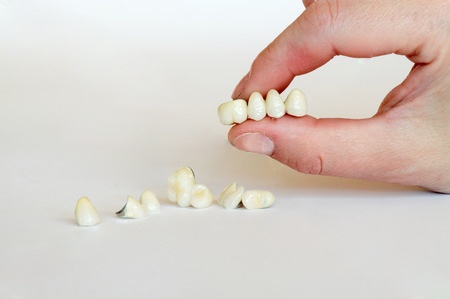Everything about dentures
Paweł Grzegorczyk, Healthy Smile Center Dentist
Prosthodontics is a field dedicated to the restoration of lost tissues and structures of facial skeleton. A dental prosthesis allows to restore the optimal functioning of complex oral-musculoskeletal disorders.
Restorations can be simply divided into:
-
fixed prosthesis, which is firmly anchored in the mouth using a special dental cements,
-
removable prosthesis, which is anchored by means of special supporting elements such as: clasps, bolts, latches, telescopes, attachement.
Fixed dentures:
• inlays (onlay, inlay)
• radix posts
• crowns
• bridges
• veneers
Inlays (onlays, inlays) are permanent andfill the large cavities in posterior teeth: premolars and molars. They provide a very accurate reproduction of the tooth hard tissues with special attention given to areas of contact and deep subgingival cavities where the use of conventional composite restorations does not give the expected results. The inlays are performed in the dental laboratory and deposited in the tooth with special cement. Most of them are made of composite, porcelain or gold.
Radix posts are permanent additions that restore the damaged tooth’s hard tissue. The tooth itself must be properly treated (root canal). Crown-root inlay, also called a "pin", is settled with cement to allow the reconstruction of the crown. This prosthesis is usually made of gold, titanium or metal free - zirconium oxide.
Prosthetic crown is a restoration allowing the reconstruction of hard tissues around a natural tooth crown. Crowns can cover live teeth or root canal treatment. While constructing a crown the shape, size and color of natural teeth may be changed.
Prosthetic bridges are permanent additions that allow the reconstruction of a missing tooth. A bridge is a special construction made up of dental crowns and teeth embedded in, which recreates the missing teeth and tissue. Bridges can be made of the same materials as crowns.
Veneers are made of a thin layer of composite or ceramic "flakes" imposed on the labial surfaces of anterior teeth. They allow the teeth to improve aesthetics by changing their color, size, shape. They are permanently embedded on the teeth with special cement. The main advantage of veneers is minimal preparation of hard tissue.
|
|




 |





